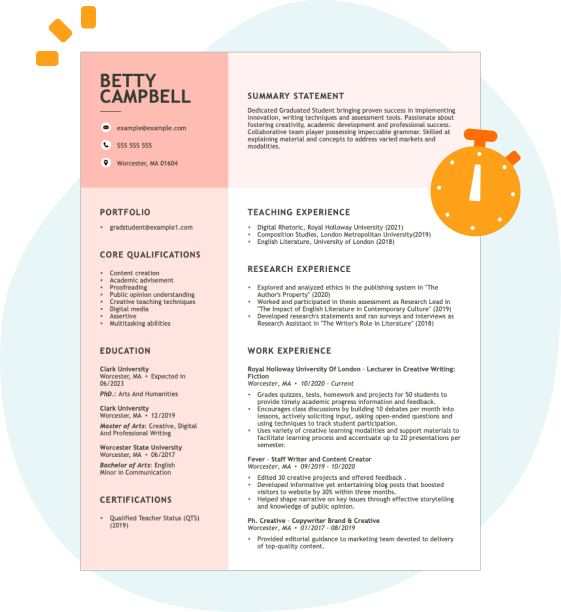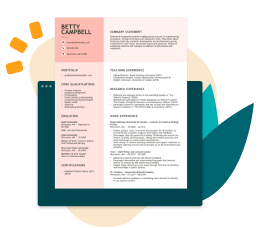Hard skills in biology include laboratory techniques, data analysis, and a strong understanding of biological processes and systems.
Popular Biology Resume Examples
Check out our top biology resume examples that highlight key skills such as research skill, analytical thinking, and laboratory techniques. These examples illustrate how to effectively showcase your accomplishments in the field.
Ready to elevate your resume? Our Resume Builder offers user-friendly templates specifically designed for biology professionals, helping you make a strong impression on potential employers.
Entry-level biology resume
This entry-level resume in biology effectively highlights the applicant's research accomplishments and technical skills. It showcases their experience in laboratory settings and contributions to environmental studies. New professionals in this field must demonstrate not only their academic achievements but also practical applications of their skills through relevant projects and certifications to attract potential employers.
Mid-career biology resume
This resume effectively showcases the job seeker's qualifications by highlighting strong leadership roles and research contributions. The structured presentation of achievements demonstrates a solid track record in advancing lab efficiency and securing funding, indicating readiness for more complex challenges in biology.
Experienced biology resume
This section demonstrates the applicant's extensive experience in biology research, highlighting significant achievements such as increasing research efficiency by 30% and publishing five scientific papers annually. The bullet point format improves readability, making it easy for hiring managers to quickly identify key accomplishments.
Resume Template—Easy to Copy & Paste
Suki Wang
San Francisco, CA 94105
(555)555-5555
Suki.Wang@example.com
Professional Summary
Accomplished biology specialist with 7 years of progressive research experience. Proficient in molecular biology, genetic analysis, and bioinformatics. Recognized for boosting efficiency and delivering impactful scientific outcomes.
Work History
Biology Specialist
EcoGenesis Research Institute - San Francisco, CA
September 2021 - October 2025
- Led 10+ experiments on plant gene expression.
- Achieved 20% improvement in lab efficiency.
- Designed biodiversity conservation strategies.
Molecular Biologist
Genova Analytics Lab - Lakeside, CA
September 2017 - August 2021
- Analyzed protein structures with 95% accuracy.
- Published 5 scientific papers in peer-reviewed journals.
- Conducted genetic testing for cancer detection.
Research Associate in Biology
BioFrontiers Innovation Hub - Riverside, CA
September 2015 - August 2017
- Maintained 100+ experimental cultures monthly.
- Reduced lab waste by 25% via optimization techniques.
- Supervised undergrad research interns effectively.
Languages
- Spanish - Beginner (A1)
- French - Beginner (A1)
- Mandarin Chinese - Beginner (A1)
Skills
- Genetic Analysis
- Molecular Biology Techniques
- Data Interpretation
- Bioinformatics Tools
- DNA Sequencing
- Scientific Writing
- Experimental Design
- Laboratory Safety Protocols
Certifications
- Certified Molecular Biologist - American Biology Association
- Advanced Bioinformatics Specialist - Genome Research Institute
Education
Master of Science Biology
University of Illinois Urbana-Champaign, Illinois
May 2015
Bachelor of Science Biological Sciences
University of Missouri Columbia, Missouri
May 2013
How to Write a Biology Resume Summary
Your resume summary is the first thing employers will see, making it important to create a compelling impression that highlights your fit for the role. As a biologist, you should emphasize your research skills, analytical abilities, and any relevant fieldwork experience.
In this section, you'll want to showcase your unique qualifications and contributions to biology. Focus on what sets you apart, including specific techniques or projects that demonstrate your expertise.
To guide you in crafting an effective summary, we’ll explore some examples that illustrate both successful and ineffective approaches:
Weak resume summary
I am a passionate biologist with many years of experience in various environments. I seek a position where I can showcase my knowledge and help the organization succeed. A job that values collaboration and offers room for advancement would be perfect for me. I believe I can contribute positively to the team if given the chance.
- Lacks specific details about the applicant’s expertise or accomplishments, making it hard to assess their qualifications.
- Overuses personal pronouns and vague language, which detracts from professionalism.
- Emphasizes personal desires instead of highlighting what value the job seeker can bring to potential employers.
Strong resume summary
Experienced biologist with over 7 years in molecular biology research, specializing in genetic sequencing and analysis. Successfully led a project that increased data processing efficiency by 30% through the implementation of advanced bioinformatics tools. Proficient in CRISPR technology, gene editing, and laboratory management to drive innovative research outcomes.
- Begins with precise years of experience and area of specialization.
- Highlights a quantifiable achievement that showcases leadership and technical advancement.
- Mentions specific technical skills and technologies relevant to biology, demonstrating expertise.
PRO TIP
Showcasing Your Work Experience
The work experience section plays a key role in your resume when pursuing opportunities in biology, as it often contains the most detailed content. Using resume templates can help ensure this section is designed to stand out effectively.
This section should be formatted in reverse-chronological order, showcasing your relevant positions clearly. For each entry, include bullet points focusing on your top achievements and contributions within the field of biology.
To clarify effective strategies, we will share examples illustrating both strong and weak approaches. These examples are intended to help you craft a work history section that makes an impact.
Biology Research Assistant
Greenwood University – Greenwood, SC
- Assisted in lab experiments.
- Recorded data and maintained files.
- Collaborated with team members.
- Helped with presentations and reports.
- Lacks employment dates for context.
- Bullet points are vague and do not highlight specific skills or achievements.
- Emphasizes routine tasks rather than strong contributions or results.
Biologist
Green Earth Labs – Seattle, WA
March 2020 - Current
- Conduct environmental impact studies on local ecosystems, leading to the identification of three key areas for conservation efforts.
- Use advanced genetic analysis techniques to improve plant resilience, achieving a 40% increase in survival rates during drought conditions.
- Mentor undergraduate interns in research methodologies and laboratory practices, fostering skill development and encouraging scientific inquiry.
- Starts each bullet with compelling action verbs that highlight the job seeker’s contributions.
- Incorporates specific metrics to illustrate tangible results of the applicant’s work.
- Showcases relevant skills essential for a biologist while highlighting mentoring capabilities.
Your resume's summary and work experience sections are important, but don't overlook the significance of other areas that also require your attention. For further insights, explore our complete guide on how to write a resume.
Top Skills to Include on Your Resume
A skills section is essential for any resume because it allows job seekers to quickly showcase their qualifications and expertise. It helps employers identify if you possess the necessary abilities required for the role at a glance.
For biology professionals, highlighting both technical skills and laboratory techniques is important. This includes skill in tools like microscopes, statistical software such as SPSS, and methods like PCR or gel electrophoresis that are important in research settings.
Soft skills encompass critical thinking, teamwork, and effective communication, which are essential for collaborating with peers and translating complex concepts into actionable insights for research and application.
Selecting the right resume skills is important for meeting employer expectations and passing automated screening systems. Companies often rely on software to identify job seekers who lack essential skills, so aligning your qualifications with those expectations is key.
To effectively highlight your skills, review job postings closely. These listings provide valuable insights into which abilities are most sought after by recruiters and will help you tailor your resume to both human readers and ATS algorithms.
PRO TIP
10 skills that appear on successful biology resumes
Highlighting relevant skills on your resume can significantly increase your chances of catching a recruiter's eye in the competitive field of biology. Our resume examples showcase these skills, enabling you to present yourself confidently when applying for positions.
Here are 10 essential skills to consider including in your resume if they align with your experience and job criteria::
Analytical thinking
Attention to detail
Laboratory skill
Data analysis
Research methodology
Communication skills
Team collaboration
Problem-solving abilities
Adaptability
Time management
Based on analysis of 5,000+ biology professional resumes from 2023-2024
Resume Format Examples
Choosing the right resume format is important because it highlights your key skills, relevant experiences, and professional growth, allowing employers to quickly assess your qualifications.
Functional
Focuses on skills rather than previous jobs.

Best for:
Recent graduates and career changers with little to no experience.
Combination
Balances skills and work history equally.

Best for:
Mid-career professionals eager to highlight their skills and growth opportunities.
Chronological
Emphasizes work history in reverse order.

Best for:
Leaders in research and advanced biological applications.
Frequently Asked Questions
Should I include a cover letter with my biology resume?
Absolutely, including a cover letter can significantly improve your job application by showcasing your personality and detailing how your skills align with the position. To get started, explore our comprehensive guide on how to write a cover letter or use our Cover Letter Generator for a quick and easy solution tailored to your needs.
Can I use a resume if I’m applying internationally, or do I need a CV?
When applying for jobs abroad, it's often necessary to use a CV instead of a resume. A CV provides a comprehensive overview of your academic background and work experience. For guidance on how to write a CV that meets international standards, explore our resources offering CV examples tailored to those requirements.
What soft skills are important for biologys?
Soft skills like critical thinking, collaboration, and effective communication are essential in biology. These interpersonal skills foster teamwork in research settings and improve the ability to convey complex concepts clearly, promoting better understanding among peers and contributing to successful scientific endeavors.
I’m transitioning from another field. How should I highlight my experience?
Highlight your transferable skills such as communication, teamwork, and analytical thinking gained from previous roles. These abilities showcase your adaptability and potential to excel in biology positions, even with limited experience. Provide concrete examples that connect your past successes to relevant responsibilities in the field, reinforcing your value to prospective employers.
Where can I find inspiration for writing my cover letter as a biology?
For those pursuing biology positions, exploring professional cover letter examples can be incredibly beneficial. These samples offer valuable insights into effective formatting and content ideas while showcasing your qualifications in a compelling way. Take the time to review them and improve your application materials with confidence.
Should I include a personal mission statement on my biology resume?
Including a personal mission statement on your resume is recommended. It effectively conveys your core values and career aspirations, which can be particularly compelling when you apply to organizations that prioritize cultural fit and have a strong commitment to their mission or community engagement.







